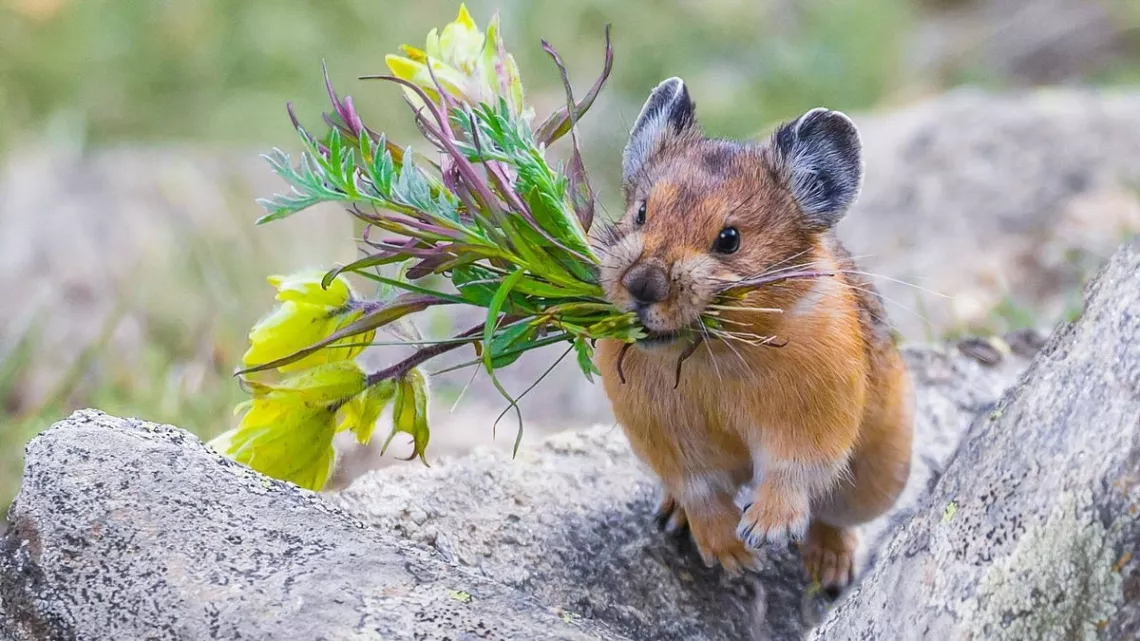by Helen Maurer
My own epiphany about climate change occurred during a Sierra Nevada backpack with my husband years ago, when we had a close encounter with a pika.
If you’ve been to Mammoth, you may have seen one as a stuffed toy souvenir. Seeing a real pika is much more difficult, as they live at higher elevations where temperatures are cooler and there are plenty of rocks to hide among when danger approaches. They are extremely shy. You might hear a sudden, high-pitched squeak and just glimpse something as it disappears. But if you did see one up close, you’d be smitten:

the pika is a little guy, who looks like a cross between a hamster and a gopher with beige-gray fur, no tail, and round Mickey Mouse ears. (And tell me: which one do you prefer, the fake toy or the real critter?)
On various trips into the Sierra, we had occasionally spotted them from afar. But this one came right into our camp.
We had stopped at the upper end of Garnet Lake, which sprawls beneath the stunningly ragged peaks of Mts Ritter and Banner in the High Sierra. Because of recent drought, this huge lake had a bathtub ring a foot or two above its water level. The surrounding patches of

meadow were dry, the sparse grass parched to a pale, brittle yellow. We were eating breakfast when a pika darted into our camp and began harvesting grass from a clump a few feet away from us next to our tent. It would select several stalks, nibble them through at the bottom, and then carry them off, up over a ledge and into the rocks where it must have had its burrow. A minute or so later, it was back to collect more grass for its winter food store. In between trips, it paused to watch us with its bright black eyes. I talked to it; it twitched its nose and stared. While it was off in the rocks, I put a few grains of couscous beside its grass patch to see if the pika was interested, but it wasn't. All it wanted was grass, and it kept packing the withered stalks away as fast as it could. We wondered if "our" little pika had somehow become used to hikers or if the drought had simply made it less cautious. We considered its probable future in the face of climate change. The pika’s numbers are observably shrinking, although a “lack of data” has kept it off the Endangered Species List. As the climate warms, it will have to move higher up the mountains, until the grass runs out and there's nowhere left for it to go.* When that happens, we will hear its sudden squeak and glimpse its Mickey Mouse ears no more. After we packed up to move on, I pulled some grass from a more distant clump and left it beside “our” pika’s rocks with a murmured apology. It was the only thing that I could do, right then, to help.
The Earth is beautiful, and life—all life—is precious. I have 5 grandchildren, all born in the first decade of this century. They will see the full effects of climate change, as will their children and the grandchildren they may have someday, whom they will love as much as I love them. But what sort of world will that be? Will it be a bleak world where too much that is beautiful and too many wonderful creatures, like the pika, are known only from old stories and pictures of what once was and has since ceased to be? And what of these children themselves, the grandchildren of my grandchildren? What is to become of them? I will never know them; I will never see their faces. But I’ve known my grandchildren all their lives so far; I have seen their faces bright with laughter, wet with tears. And that is why I must care about a future that I personally will never know, and why I must do everything in my power while I’m here to make it a good, sustainable, livable future for all Earth’s children. For if I do not do this, I will break their hearts.
*For more on the pika and its status, see: OR Related Articles:
National Park Service, https://www.nps.gov/articles/pikas-in-peril.htm
National Wildlife Federation, https://www.nwf.org/Educational-Resources/Wildlife-Guide/Mammals/American-Pika
Stewart, Joseph A.E., David H. Wright and Katherine A. Hackman, “Apparent climate-mediated loss and fragmentation of core habitat of the American pika in the Northern Sierra Nevada, California, USA,” PLOS (August 30, 2017), https://journals.plos.org/plosone/article/authors?id=10.1371/journal.pone.0181834
For a more hopeful view of the pika’s future, see:
Andrew Smith, “Pikas are adapting to climate change remarkably well, contrary to many predictions,” The Conversation (January 7, 2021), https://theconversation.com/pikas-are-adapting-to-climate-change-remarkably-well-contrary-to-many-predictions-150726
The pika’s situation is complicated. Clearly, the animal’s ability to move to and to establish itself in new locations that somehow provide conditions in which it can survive will be critical to its overall survival.